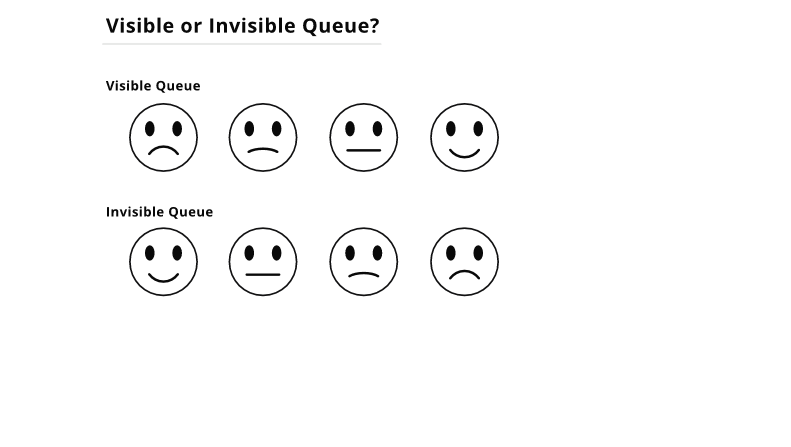Date Published October 18, 2022 - Last Updated January 20, 2023
Queues are a fact of life—especially now, given staffing shortages and growing workloads in many organizations. Answering every contact immediately would take as many staff as inbound contacts at any given moment.
So, how do customers perceive queues?
First, a note on terminology: Queue comes from the word cue, a term from Old French that means “line of waiting people.” The term is common in everyday British English (less so in North America, where “line” is typical) and appears frequently in customer service terminology. Frustrated customers still tend to say “I’m on hold” rather than the more-precise “I’m in queue.”

The figure represents customer perceptions of the two major types of queues—visible and invisible. The top row of faces in the figure reflects a queue that customers can “see” (e.g., grocery store, stadium, ride at the county fair). The first face represents how people feel as they enter the queue. As they move forward, the subsequent faces illustrate their progress. The final face reflects the fact that they “made it.”
The second row of faces represents a setting where customers are unaware of the length of the queue they are entering. Ignorance is bliss, and expectations are initially high. But after some amount of waiting, often 15 or 20 seconds, they begin to doubt that they are going to get right through (second face). The third face illustrates the transition from doubt to mild frustration. By now, they have heard the first and maybe second delay announcement and they know they are in a queue.
The fourth face represents customers who, from their perspective, have waited too long. Often, the first thing they do when they reach an agent is mention the difficulty they had getting through. That lengthens handling time, which will back up the queue even more and cause even more customers to complain to agents—a downward spiral.
And there’s another phenomenon that kicks in here. Customers who have waited a long time in queue tend to “dig in their heels” as they attempt to squeeze all the value out of the interaction that they can: “Um, let me ask one more question while I have you.”
Visible Queue
There’s a fascinating history of organizations that pioneered ways to make wait times known to customers. Software company WordPerfect created the first “visible queue” (or more literally, “audible queue”) in the mid-1980s. They set up their system to enable live “queue jockeys” to make announcements of expected hold times to callers. They also could play music and deliver announcements to keep callers entertained and informed while they waited:
Thank you for calling WordPerfect. If you just joined us, the wait is just over three minutes. Now, here’s Kenny G from his latest album ...
WordPerfect discovered that customers who abandon a visible queue do so at the beginning. Those who decide to wait generally do so until they reach an agent.
Many customer service managers keep a diligent eye on how many customers abandon (give up on a call, chat, or other type of contact). But when customers abandon is also an important consideration. If they are abandoning early on because they are making an informed choice, that’s much different than waiting for what seems like a long time in an invisible queue before abandoning in frustration.
What the queue jockey never said, but what was implicit in the message, was something like:
Thanks for calling. If you’re going to abandon, would you kindly do so now, before you get frustrated, drive up our costs and clog up the queue only to abandon anyway?
Routing systems that could “tell time” began to appear in the early 1990s. Today’s technologies can analyze real-time variables, make predictions, and announce or display expected wait times to customers as they arrive. They can give customers the option to hang up and receive a callback when an agent becomes available, without losing their place in queue.
Estimated wait times are a great feature, but there’s a catch. These systems provide fairly accurate predictions in reasonably straightforward environments, especially for large agent groups. However, if you are using any form of priority or skills-based routing, the system can outsmart itself. Some customers have found themselves actually moving backward in queue as “priority” calls arrive and are moved to the front of the queue. This is a challenge that system designers have yet to conquer fully.
Given the choice, customers want to know what’s happening, and they want alternatives, e.g., to continue to wait or receive a callback without losing their place in queue. Even more, of course, they want to get through quickly and easily.
This article first appeared in ICMI, a partner publication.
Brad Cleveland is known globally as one of today’s foremost experts in customer strategy and management. He has worked across 45 states and 60 countries for clients as diverse as American Express, Apple, USAA, the University of California and the federal governments of Australia, Canada, and the U.S. Brad was a founding partner in and former CEO of the International Customer Management Institute (ICMI). His books include Contact Center Management on Fast Forward (ICMI, 4th edition 2019) and Leading the Customer Experience (Kogan Page, 1st edition 2021). Contact info: www.bradcleveland.com
Connect with Brad:
Twitter: @bradcleveland
Email: [email protected]
LinkedIn: www.linkedin.com/in/bradcleveland1
Blog: www.bradcleveland.com/blog